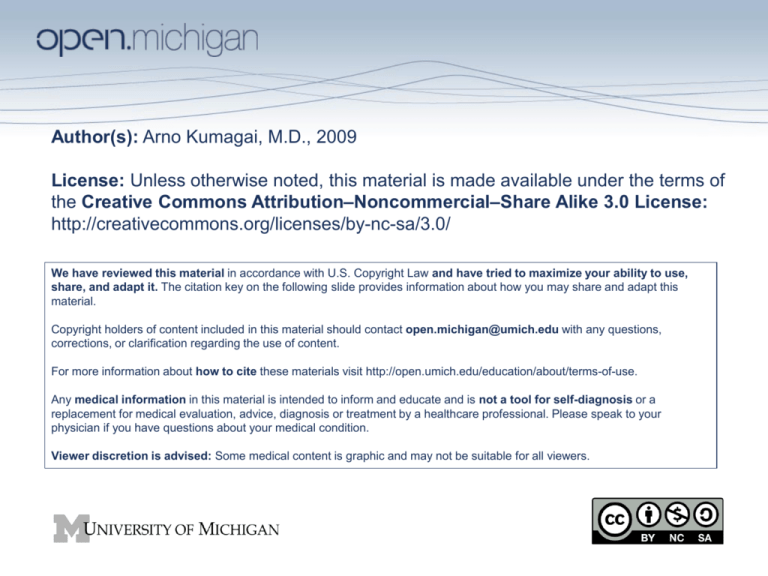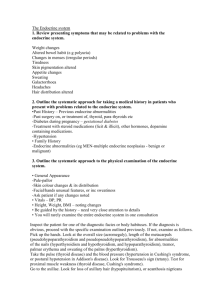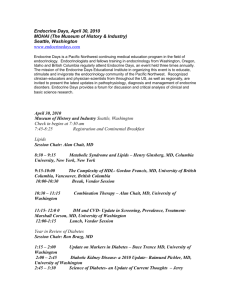Endocrine Photos: Acromegaly - Open.Michigan
advertisement

Author(s): Arno Kumagai, M.D., 2009
License: Unless otherwise noted, this material is made available under the terms of
the Creative Commons Attribution–Noncommercial–Share Alike 3.0 License:
http://creativecommons.org/licenses/by-nc-sa/3.0/
We have reviewed this material in accordance with U.S. Copyright Law and have tried to maximize your ability to use,
share, and adapt it. The citation key on the following slide provides information about how you may share and adapt this
material.
Copyright holders of content included in this material should contact open.michigan@umich.edu with any questions,
corrections, or clarification regarding the use of content.
For more information about how to cite these materials visit http://open.umich.edu/education/about/terms-of-use.
Any medical information in this material is intended to inform and educate and is not a tool for self-diagnosis or a
replacement for medical evaluation, advice, diagnosis or treatment by a healthcare professional. Please speak to your
physician if you have questions about your medical condition.
Viewer discretion is advised: Some medical content is graphic and may not be suitable for all viewers.
Citation Key
for more information see: http://open.umich.edu/wiki/CitationPolicy
Use + Share + Adapt
{ Content the copyright holder, author, or law permits you to use, share and adapt. }
Public Domain – Government: Works that are produced by the U.S. Government. (17 USC § 105)
Public Domain – Expired: Works that are no longer protected due to an expired copyright term.
Public Domain – Self Dedicated: Works that a copyright holder has dedicated to the public domain.
Creative Commons – Zero Waiver
Creative Commons – Attribution License
Creative Commons – Attribution Share Alike License
Creative Commons – Attribution Noncommercial License
Creative Commons – Attribution Noncommercial Share Alike License
GNU – Free Documentation License
Make Your Own Assessment
{ Content Open.Michigan believes can be used, shared, and adapted because it is ineligible for copyright. }
Public Domain – Ineligible: Works that are ineligible for copyright protection in the U.S. (17 USC § 102(b)) *laws in
your jurisdiction may differ
{ Content Open.Michigan has used under a Fair Use determination. }
Fair Use: Use of works that is determined to be Fair consistent with the U.S. Copyright Act. (17 USC § 107) *laws in
your jurisdiction may differ
Our determination DOES NOT mean that all uses of this 3rd-party content are Fair Uses and we DO NOT guarantee
that your use of the content is Fair.
To use this content you should do your own independent analysis to determine whether or not your use will be Fair.
Images of Endocrine Disorders
M2 - Endocrinology Sequence
A. Kumagai & T. Giordano
NOTE: BEST VIEWED AS SLIDE SHOW
Winter 2009
Images of Endocrine Disorders
Because endocrine disorders are manifested by unusual and varied
clinical findings, diagnosis often involves developing a “gestalt”--an
overall picture of the individual with a possible endocrine disorder-and matching of this picture with characteristic clinical features.
The purpose of the following photographs is to give you a “gallery”
of these characteristic features to help you to remember elements of
several different disease processes. The material is meant to
reinforce information provided in lectures, handouts and discussion
groups (and hopefully to have some fun while doing it.) Please refer
to required materials for details.
Endocrine Images: Acromegaly
Andre the Giant by EKavet (Flickr)
acromegaly.org.uk
Picture of wrestling star Andre the Giant and Skull X-ray of
man with acromegaly. Notice the characteristic prominent
supraorbital ridge (“frontal bossing”), large jaw, and dental
malocclusion with underbite (x-ray).
Endocrine Images: Acromegaly
28 yrs
49 yrs
55 yrs
65 yrs
Greenspan & Strewler, Basic & Clinical Endocrinology, 5th Ed., 1997 From Reichlin S. Acromegaly. Med
Grand Rounds 1982;1:9
Individual with acromegaly photographed over a 37-year span. Ages in
years are in lower left corner of each photograph.
Note that the changes occurring with acromegaly may be very gradual and go
completely undetected by the patient or his or her family for many years. It is
often only thorough the comparison with old photographs or complaints
involving complications of acromegaly, such as sleep apnea, diabetes or dental
problems that acromegaly is suspected.
Endocrine Images: Acromegaly
University of Iowa Dept. of Dermatology
Hands of individual with acromegaly (left) compared to
hand of non-acromegalic adult (far right).
Endocrine Images: Acromegaly
Amilcare Gentili, M.D.
Foot X-ray of Patient with Acromegaly.
Notice the unusually thick “pad” of soft tissue overlying the calcaneus
(double arrow). It is said that a good clinical sign of acromegaly is
the inability to feel the calcaneus when pressing on the heel.
Endocrine Images: Acromegaly
Clinical Findings in Acromegaly.
Symptoms & Signs:
• Excessive sweating, snoring.
• Arthalgias, carpal tunnel syndrome.
• Change in ring/glove or shoe size.
Signs:
• Dental malocclusion and widely spaced teeth.
• Macroglossia.
• Large hands and feet.
• Large heart (may see signs of heart failure).
Laboratory results:
• Impaired glucose tolerance or diabetes.
• Elevated IGF-1.
• Enlarged cardiac silhouette on chest x-ray.
Greenspan & Strewler, Basic & Clinical Endocrinology, 5th Ed., 1997 From Reichlin S. Acromegaly. Med
Grand Rounds 1982;1:9
Endocrine Images: Graves Disease
The Handbook of Ocular Disease Management.
Graves Ophthalmopathy (Exophthalmos).
Graves ophthalmopathy is due to autoimmune-mediated inflammation and edema of
the extraocular muscles. Graves eye disease may be asymmetrical and often progresses
independently of hyperthyroidism and may lead to diplopia, corneal dryness, ulceration,
and blindness. Severe cases may require surgical decompression. Exophthalmos is
specific to Graves disease. On the other hand, “lid lag,” in which the eyelids do not
closely follow downward gaze, may be seen in all forms of hyperthyroidism and is due to
hyperstimulation of the orbicularis occuli muscles.
Endocrine Images: Graves Disease
This photo was taken from Dr. Koenig’s thyroid
lecture and is meant to highlight the eye findings
in Graves disease: the classic “stare” of
hyperthyroidism and a prominent goiter. Notice
in Graves that the thyroid is symmetrically
enlarged and “plump.” This is because the
entire thyroid is being stimulated by thyroid
stimulating immunoglobulin (TSI), which causes
constitutive activation of the TSH receptor in the
absence of TSH. Auscultation of the goiter of
an individual with active Graves disease may
reveal a thyroid bruit, due to the
hypervascularity of the overactive gland. This
bruit must be distinguished from cardiac (or
carotid) bruits by localizing its source over the
thyroid.
Source Undetermined
Endocrine Images: Graves Disease
Dermnet
Graves Dermopathy
Graves dermopathy is also known as “pretibial
myxedema,” which is an unfortunate term,
since “myxedema” usually refers to
hypothyroidism. The term “myxedema”
describes the “doughy” or “peau d’orange”
texture of the skin. Graves dermopathy
involves inflammation and
mucopolysaccharide deposition most
prominently in the pretibial regions of the legs.
It is a relatively uncommon--albeit, classic-finding in Graves disease and affects
approximately 5% of patients with Graves.
Endocrine Images: Graves Disease
Clinical Findings in Graves Disease.
Symptoms & Signs:
• Heat intolerance, excessive sweating.
• Anxiety, “hyperkinesis.”
• Sleep disturbances.
• Weight loss despite increased appetite.
• Hyperdefecation (not diarrhea).
Source Undetermined
Signs:
• Tachycardia, wide pulse pressure.
• Warm, moist skin.
• Exophthalmos may be present.
• Symmetrical, “plump” goiter.
• Fine tremor of outstretched hands.
• Brisk reflexes.
Endocrine Images: Hypothyroidism
Greenspan & Strewler, Basic
& Clinical Endocrinology, 5th
Ed., 1997
University of
Missouri Health
Systems
Child with Congenital
Hypothyroidism (cretinism)
Woman with Severe
Hypothyroidism
This pair of photographs illustrates some general physical features of congenital
hypothyroidism and severe hypothyroidism in an adult. The face is has a puffy,
“doughy” appearance (hence, the term “myxedematous”). Periorbital edema may be
present. The skin is dry and cool, and the hair is coarse. The affect is blunted and
apathetic. The child is short and has mental retardation.
Endocrine Images: Hypothyroidism
Clinical Findings in Hypothyroidism.
Symptoms & Signs:
• Depression.
• Cold intolerance.
• Weight gain despite unchanged appetite.
• Constipation.
Woman with Severe
Hypothyroidism
Signs:
• Bradycardia, diastolic hypertension.
• “Myxedematous facies” with coarse hair.
• Distant heart sounds.
• Delayed relaxation phase of achilles reflex.
Laboratory results:
• Anemia: either macrocytic or normocytic.
• Hyponatremia (due to decreased free water clearance by the kidney).
• Elevated TSH, low free T4 (primary hypothyroidism). [Note: since
free T3 may remain normal until hypothyroidism is severe it is useless
in the diagnosis of hypothyroidism.]
Greenspan & Strewler, Basic & Clinical Endocrinology, 5th Ed., 1997
Endocrine Images: Cushings Syndrome
Mt. Zion-UCSF
Source Undetermined
Prominent physical findings in Cushings syndrome include round “moon facies,”
supraclavicular and supracervical fat pads (“buffalo hump”), central obesity and
purple abdominal striae. If the result of a pituitary adenoma (Cushings Disease),
hyperpigmentation may be present. If an adrenal cortical carcinoma is the cause,
there may be hirsuitism and virulization. (Adrenal carcinomas may produce DHEA
sulfate, a potent adrenal androgen.) Adrenal carcinomas also grow more rapidly than
adrenal adenomas and tend to be larger: almost always > 5 cm in diameter on an
abdominal CT scan.
Endocrine Images: Cushings Syndrome
Abdominal Striae in Cushings Syndrome.
Classically, these striae are purplish in color and
appear on the abdomen, thighs, upper arms and axillae.
They are distinguished from silver striae seen in
postpartum women or pink striae seen with significant
weight loss.
Excessive steroid action on skin also may lead to
skin fragility and easy bruising during routine activities.
G. Hammer, MD, PhD University of Michigan (Both images)
Endocrine Images: Adrenal Insufficiency
NEJM 337:1666, 1997
This slide of identical twins is from Dr. Hammer’s lecture and is meant to
emphasize the hyperpigmentation and thin body habitus that is often seen
in primary adrenal insufficiency (the woman with adrenal insufficiency is
on the right). Hyperpigmentation may also be seen in the extensor
surfaces of the limbs (knuckles, elbows, knees), in newly formed scars and
in palmar creases and buccal mucosa. (What’s the cause?)
Endocrine Images: Addison’s Disease
Clinical Findings in Addison’s Disease.
Symptoms & Signs:
• General malaise, fatigue.
• Weakness and difficulty climbing stairs, arising
from sitting, combing or shampooing hair.
• Salt craving.
NEJM 337:1666, 1997
Signs:
• Orthostatic hypotension.
• Hyperpigmentation of extensor surfaces of skin,
buccal mucosa, palmar creases.
• Weakness of proximal muscle groups.
Pertinent routine laboratory results:
• Normocytic anemia
• Neutropenia (mild) with eosinophilia.
• Hyponatremia, hypokalemia and “non-gap” metabolic acidosis.
• Mild hypoglycemia (may be pronounced in infants).
Endocrine Images: Addison’s Disease
Williams Textbook of Endocrinology, 8th Ed, 1996.
Hyperpigmentation in Addison’s Disease.
In primary Addisons disease, one often sees hyperpigmentation of extensor
surfaces of the limbs (knuckles, elbows, knees), of the areolae of the breasts, of
newly formed scars, and of the buccal mucosa. In this photograph, one may see
darkening of the face, fingertips and gingiva as well. (What’s the mechanism?)
Endocrine Images: Addison’s Disease
T. Addison “On the constitutional
and local effects of disease of the
suprarenal capsules” 1855
Hyperpigmentation in Addison’s Disease.
This is a (presumably) postmortem drawing from Addison’s original paper of an
individual with primary adrenal insufficiency. In Addison’s day, the primary cause was
not autoimmune adrenalitis, but tuberculosis.
Endocrine Images: Addison’s Disease
James Andrews of Maidenhead
Jane Austin (1775-1817)
The great British novelist Jane Austin also suffered from Addison’s disease
and died prematurely of its complications. If you look closely, you can see
areas of hyperpigmentation on her cheeks…but again, this might be the
product of an over-worked endocrinologist’s imagination…
Endocrine Images: Lipodystrophy in Diabetes
Lipohypertrophy (arrow) in
individual who injects insulin
predominantly in lower abdomen.
Lipoatrophy in buttocks and
upper thighs (arrows) in
individual with type 1 DM
Lipodystrophy (lipohypertrophy and lipoatrophy) may
be seen as a side effect of insulin therapy.
• Lipohypertrophy is common and occurs in areas of
frequent insulin injections. It is caused by hyperplasia
and hypertrophy of subcutaneous fat from prolonged
exposure to high insulin concentrations and may affect
insulin absorption and action. Lipohypertrophy may
be seen in individuals with type 1 or type 2 diabetes.
• Lipoatrophy is much less common (especially with the
current use of recombinant human insulins) and is
seen in individuals with type 1 diabetes. Its cause
appears to be an autoimmune reaction and is
characterized by complement deposition in
subcutaneous tissue.
• Generalized lipoatrophic syndromes are rare and may
occur independently from insulin-treated diabetes.
Pickup & Williams, 1991 (Both images)
Endocrine Images: Foot Problems in Diabetes
Diabetic “Charcot Feet” with
bone abnormalities
Diabetic Foot Ulcer
Gangrene of the First and Fifth Toes
Source Undetermined (All Images)
Endocrinologists spend a great deal of time looking at people’s feet. Foot problems
are very common in diabetes and may result from diabetic sensory neuropathy, a lack
of normal sweat response and dry feet (from compromised sweat gland innervation),
and poor circulation from peripheral vascular disease. Sensory neuropathy leading to
permanently “numb” or “insensate” feet predispose the feet to unrecognized trauma
and abnormal weight-bearing. This in turn may lead to cracks, fissures, and ulcers or
the development of so-called “Charcot Feet,” which involve bony changes and
gradual, severe skeletal deformation. Ulcers may be very slow to heal and if deep,
may lead to osteomyelitis, cellulitis and gangrene.
Remember: Diabetes is the leading cause of non-traumatic lower extremity
amputation in the United States.
Endocrine Trivia: Diabetic Feet
Source Undetermined
Diabetic “Charcot Feet”
10-Gram
Monofilament
Handle
A. Kumagai
The term “Charcot feet” used to describe bony
deformation in diabetes comes from the great
French neurologist (and Sigmund Freud’s former
professor ) Dr. Jean-Martin Charcot of the Hôtel
Dieu Hospital in Paris. Charcot originally
described similar lower extremity changes in
another disease…tabes dorsalis associated with
neurosyphyllis….
In addition to a 128-Hz tuning fork, a 10-gram
monofilament (similar to a straight piece of fishing line)
is frequently used to assess the severity of diabetic
peripheral neuropathy. Failure of the patient to feel the
touch of the filament is associated with a significantly
increased risk of developing foot ulcers.
This instrument was actually originally developed to
assess the peripheral neuropathy seen in another
disease… “Hansen’s Disease” or leprosy...
Endocrine Images: Diabetes
University of Iowa Dermatology
Necrobiosis lipodica diabetacorum.
Indurated, nontender ulcerations of the lower
extremities occasionally seen in individuals with
type 1 diabetes.
A Gallery of
Endocrine Images:
Famous Names in Endocrinology
Famous Names in Endocrinology
Acromegaly
• Robert Wadlow, the “Alton Giant” 1918-1940
Robert Wadlow, the “Alton Giant” is said to be the tallest human in
history, stood at 8’11 ½” and died at age 22 from an infected leg
ulcer. He was very spiritual, was a Boy Scout, and briefly attended
college until his death.
• Lurch of the Original Addams Family
• Andre the Giant
• “Jaws” of the James Bond Movie Fame
Images of Robert
Wadlow, Lurch,
Andre the Giant,
and “Jaws”
removed
Endocrine Images: Addison’s Disease
1960 Presidential Debate: John F. Kennedy vs.
Richard M. Nixon, Chicago, Ill., September 21, 1960
The Kennedy-Nixon debate in 1960 by scriptingnews (flickr)
In the first-ever televised presidential debate, John F. Kennedy was
the apparent winner over Richard M. Nixon, a win which helped him
in his narrow victory over Nixon in the presidential election of
November, 1960. Many observers attributed Kennedy’s “telegenic”
character to his youthful, dynamic, tanned (i.e., “hyperpigmented”)
appearance...
Endocrine Disorders and World History
Marshall Josip “Broz” Tito
of Yugoslavia and
US President John F.
Kennedy, 1962.
Yugoslav Government
Endocrine disease has clearly affected the course of world
history. Kennedy’s year-around “tan” (from his Addison’s disease)
helped him win the presidency and lent a youthful air to “Camelot,”
as the Kennedy White House was known, whereas Tito’s death
from complications from type 2 diabetes in 1980 eventually led to
the break-up of the Yugoslavian federation and the bloody Balkan
wars and “ethnic cleansing” of the 1990’s.
Famous Names in Endocrinology
Images of Marty
Feldman and Gene
Wilder removed. Poster
from the movie Young
Frankenstein removed.
Graves Disease
Marty Feldman, star of a series of classic movies by Mel Brooks had
Graves disease. Hint: Feldman is the guy on the right. The man on
the left is Gene Wilder. He has no endocrine disorder but is just
pretty wacky...
Famous Names in Endocrinology
U.S. Navy, (wikimedia commons)
Graves Disease
Both Bushes were diagnosed with Graves disease: Barbara had
Graves ophthalmopathy and George presented with atrial
fibrillation. Their dog, Millie, had lupus. No kidding. Must be
the water...
Famous Names in Endocrinology
Cecil Stoughton, White House
James Andrews of Maidenhead,
1870
Addison’s Disease
We now all know about John F. Kennedy, but the novelist Jane
Austin was also afflicted with adrenal insufficiency. Her Addison’s
disease worsened as she grew older, and she finally succumbed to it
at the age of 41 in Winchester, in Central Hamshire (UK) in 1817.
Famous Names in Endocrinology
University of Toronto Archives
Frederick Banting (right) and Charles Best (left),
University of Toronto, 1922.
Type 1 Diabetes
The beleaguered looking beagle is one of several dogs whose
pancreatectomies were instrumental in experiments leading to the
discovery of insulin in 1922.
Famous Names in Endocrinology
•Mary Tyler Moore
•1999 Miss America Nicole Johnson
•1996 Atlanta Olympic Gold Medalist Gary Hall, Jr.
Images of Mary
Tyler Moore,
Nicole Johnson,
and Gary Hall
removed
Type 1 Diabetes: Recent
Both actress Mary Tyler Moore and the 1999 Miss America, Nicole Johnson,
have type 1 diabetes. Both women have done much to publicize the issue of
diabetes awareness in general, and of type 1 diabetes in particular. Gary Hall,
Jr. won gold and silver at the 1996 Summer Olympic Games in Atlanta.
Famous Names in Endocrinology
Unable to Load
Image
Type 1 Diabetes: Before 1922
A “trick” question, since before the invention of insulin,
no one with type 1 diabetes lived long enough to become
famous…..
Famous Names in Endocrinology
Eric Draper, White House
Carl Van Vechten
Type 2 Diabetes
We now all know about B.B. King, but the jazz great Ella Fitzgerald also
had type 2 diabetes. Ms. Fitzgerald suffered from neuropathy and
peripheral vascular disease, which necessitated lower extremity amputation
prior to her death…We miss you Ella...
Additional Source Information
for more information see: http://open.umich.edu/wiki/CitationPolicy
Slide 5: CC: BY-SA Andre the Giant by Ekavet, Flickr, http://creativecommons.org/licenses/by-sa/2.0/deed.en; acromegaly.org.uk,
http://www.acromegaly.org.uk/
Slide 6: Greenspan & Strewler, Basic & Clinical Endocrinology, 5th Ed., 1997 From Reichlin S. Acromegaly. Med Grand Rounds 1982;1:9
Slide 7: University of Iowa Dept. of Dermatology
Slide 8: Amilcare Gentili, M.D., http://www.gentili.net/
Slide 9: Greenspan & Strewler, Basic & Clinical Endocrinology, 5th Ed., 1997 From Reichlin S. Acromegaly. Med Grand Rounds 1982;1:9
Slide 10: The Handbook of Ocular Disease Management.
Slide 11: Source Undetermined
Slide 12: Dermnet, http://www.dermnetnz.org
Slide 13: Source Undetermined
Slide 14: University of Missouri Health Systems, http://www.hsc.missouri.edu; Greenspan & Strewler, Basic & Clinical Endocrinology, 5th Ed., 1997
Slide 15: Greenspan & Strewler, Basic & Clinical Endocrinology, 5th Ed., 1997
Slide 16: Mt. Zion-UCSF; Source Undetermined
Slide 17: G. Hammer, MD, PhD University of Michigan (Both images)
Slide 18: NEJM 337:1666, 1997
Slide 19: NEJM 337:1666, 1997
Slide 20: Williams Textbook of Endocrinology, 8th Ed, 1996.
Slide 21: T. Addison “On the constitutional and local effects of disease of the suprarenal capsules” 1855
Slide 22: James Andrews of Maidenhead
Slide 23: Pickup & Williams, 1991 (Both images)
Slide 24: Source Undetermined (All Images)
Slide 25: Source Undetermined; A. Kumagai
Slide 26: University of Iowa Dermatology
Slide 29: CC: BY-SA The Kennedy-Nixon debate in 1960 by scriptingnews (flickr) http://creativecommons.org/licenses/by-sa/2.0/deed.en
Slide 30: Yugoslav Government, http://commons.wikimedia.org/wiki/File:Marshal_Tito_Greeting_President_John_Kennedy.jpg
Slide 33: Cecil Stoughton, White House; James Andrews of Maidenhead, 1870
Slide 34: University of Toronto Archives
Slide 37: Eric Draper, White House; Carl Van Vechten, http://commons.wikimedia.org/wiki/File:YoungElla.jpg





